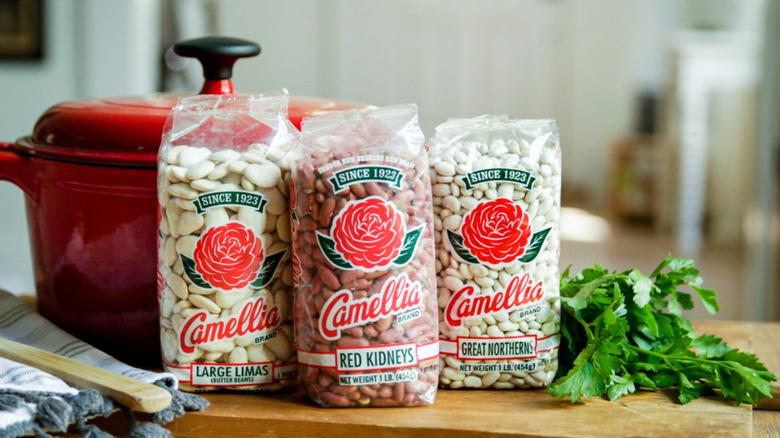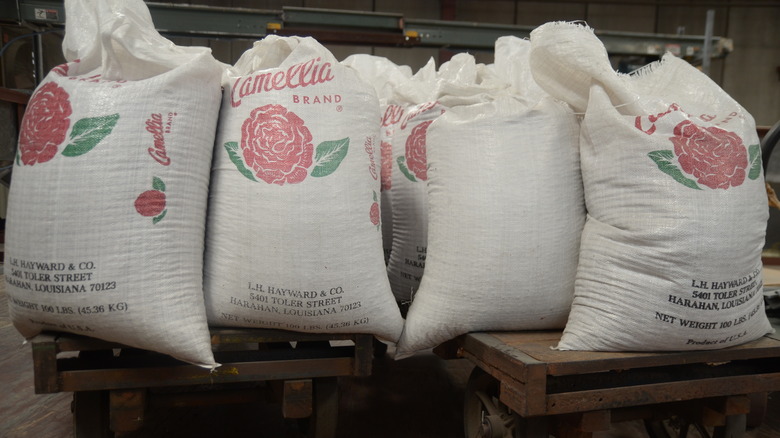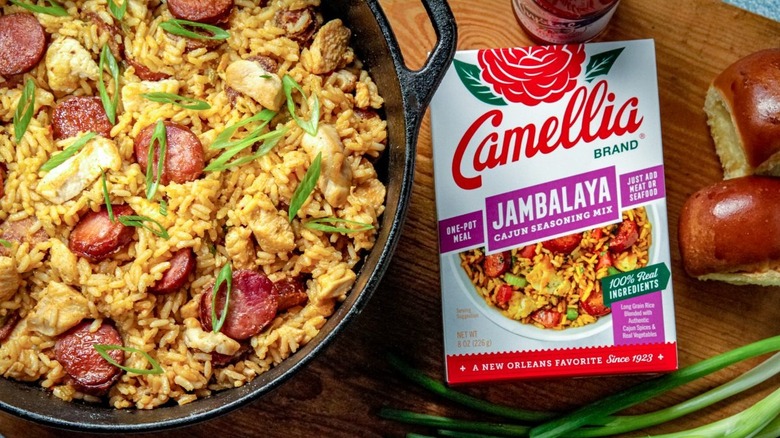New Orleans' Camellia Bean Company Has Been In Business For 100 Years
CORRECTION 2/13/23: A previous version of this article named Vince Hayward as the grandson of the Camellia company's founder. Hayward is the founder's great-great-great-grandson.
According to the US Dry Bean Council, American farmers plant nearly 2 million acres of dry beans each year, with pintos ranking No. 1 by consumers. But, ask any New Orleans native, and they'd beg to differ. The red kidney bean is their bean of choice.
"Rich, poor, black, white, everybody eats red beans. So, it has this unifying power. The bean, as a symbol of our city, it's really a part of our identity," says Devin Du Wulf, founder of The Krewe of Red Beans (via YouTube). This group is known for putting on The Bean Parade in New Orleans — a Lundi Gras tradition for fourteen years. So while red beans have obviously been rooted in New Orleans history, Camellia became part of that narrative 100 years ago, notes Lousiana Travel.
What makes this company's beans stand out? Camellia vows that the "Hayward Standard" is that secret ingredient. In a press release, Vince Hayward, the CEO and founder's great-great-great-grandson, explains the term is "about quality and control." Though the beans are processed in New Orleans, they're grown by farmers across the U.S. depending on the bean varietal's terroir requirements.
In a statement sent to Tasting Table, Hayward says, "Our family has been working together with generations of farmers for nearly a century, growing beans to the highest standards of goodness and getting them to market." And with 100 years under its belt, Camellia has many reasons to celebrate.
Camellia grew from a place of survival and sense of community
According to a press release, founder Lucius H. Hayward, Jr. started his career as a horse-and-buggy salesman for the National Biscuit Company, now known as Nabisco, and then shifted the path by becoming his own boss in 1923. He sat up shop with carts filled with dried red kidney beans along the Mississippi River on Front Street in New Orleans, and two years later, he became a founding member of the city's Board of Trade committee for dried beans and peas.
When the Great Depression rendered New Orleans hungry, it was Camellia beans that sustained the community. "We are a company that began with my great grandfather, a self-made businessman. His early life would not be characterized by riches. ... so understanding what it takes to survive is something we are reminded of within each generation of Haywards," Vince Hayward tells Tasting Table. The company has followed suit during crises such as Hurricane Katrina and the COVID-19 pandemic by providing assistance to military chefs and donating red beans.
The '40s brought some changes to the company. In 1940, L.H. Jr's son, William Gordon Hayward, realized the beans were easily transported and stored, causing a shift to packaging the beans in individual bags. This piqued the U.S. military's interest, and they began a business relationship that continues to thrive. And then, in 1947, the company trademarked its brand inspired by the Hayward matriarch's favorite flower — the camellia. Around 27 years later, Camellia moved to the outskirts of New Orleans to expand its footprint and continue its legacy.
Red beans and rice started as a simple meal and grew to become a tradition
Camellia's website lists 19 varieties of dried beans, peas, and lentils available at grocery stores, for online ordering, and through subscription boxes. The most popular varieties are pink beans, Great Northern beans, lime beans, black-eyed peas, and pinto beans. Still, the one that started it all tops the list — red kidney beans.
Fun fact: New Orleans jazz legend Louis Armstrong favored red beans so much that he would often sign letters with "Red Beans and Ricely Yours," per NPR. So how exactly did this iconic combo get its start?
Louisiana Travel points to the popularity of red beans originating from America's enslaved people from 300 years ago or the Acadian immigrants of the 1750s, although it remains unclear. Camellia shares that the idea to mix rice with red beans is most likely credited to French-speaking Haitians who brought their spicy Caribbean recipes to the city due to the revolution in Saint Domingue.
Either way, "the city's deep love for red beans" became expressed through making them part of a Monday night dinner that was typically combined with leftover ham bone from Sunday's meal — and eventually, rice got thrown into the mix. This hearty, flavorful dish then grew to become a New Orleans staple.
If you want to celebrate with Camellia by channeling the energy of Du Wulf's Bean Krewe, the brand has a variety of merchandise and gifts available. Or, you could opt to purchase your own batch of Camellia beans for a DIY parade inspired by the annual Lundi Gras in New Orleans — the Monday before Fat Tuesday.


